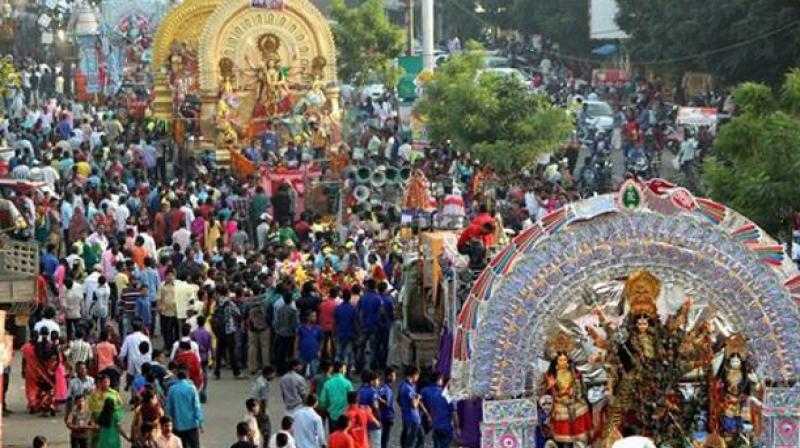In Bengal, politics over Durga Puja will misfire
Bengalis don't like their ideals and idols being dragged into politics for electoral gain.;

Durga Puja is the festival every Bengali looks forward to. Ma Durga, the 10-armed mother goddess, is not only revered but loved by the people of Bengal. According to folklore, these four Puja days mark the goddess’ annual visit to her parental home (Bengal) from her husband’s Mount Kailash abode. This belief makes it not just a religious event but a celebration of a beloved daughter’s homecoming. Durga Puja is not just a religious occasion, it’s the biggest cultural festival for Bengalis with a strong emotional overture. The controversy over the West Bengal government’s decision to ban Durga idol immersions on the day after Bijoya Dashami, which happens to coincide with Muharram, and the Calcutta High Court’s subsequent striking down of the government order are being seen, quite rightly, as an attempt to politicise Durga Puja. Though there is no doubt Mamata Banerjee plays the Muslim card without much subtlety, one has to recognise that her votebank is far more broad-based, a majority of whom are Hindus, including middle class Hindus. It is doubtful that an astute politician like Ms Banerjee would attempt “Muslim appeasement” on an occasion like Durga Puja, which traditionally in Bengal has invo-lved all communities, including minorities.
It’s not also the first time such a decision was taken. In 1982 and 1983, Muharram fell the day after Bijoya Dashami, and the then Left Front government took a similar decision, but without any hue and cry. What was perhaps a purely administrative move to preempt any untoward violence in the backdrop of recent communal clashes in the state, most of which was orchestrated, was deliberately turned into a political controversy; and the flaring of this controversy is not rooted in West Bengal but seems to originate from directions and stimuli from outside the soil of Bengal. The BJP’s practised strategy of polarising society on communal lines for electoral gain, however, might not work in Bengal. There’s a clear lack of understanding in the minds of BJP/RSS leaders about Bengal’s socio-cultural ethos. Bengalis, by and large, including Bengali Hindus, have a strong sense of cultural identity that wouldn’t allow the Nagpur version of Hindutva to be imposed in the state. Historically, the reforms within Hinduism in the Bengal Renaissance had their inspiration in rationalism and the concept of enlightenment rather than religious revisionism. Raja Ram Mohun Roy’s crusade against the abolition of sati, and Ishwar Chandra Vidyasagar’s tireless efforts for widow remarriage and girls’ education stemmed from a genuine desire to reform society than to reform Hinduism, though the prevailing arguments sought endorsements from anci-ent Hindu texts to placate the conservatives. The prevalence of the Shakti cult made fish-loving Hindu Bengalis, including Bengali Brah-mins, very different from the Hindutva propagandists of Nagpur.
A hotbed of communal politics just before Independence, and having undergone a bloodbath during Partition, Bengal has rarely seen any largescale communal violence in the post-Independence era. Despite being the home state of Dr Syama Prasad Mookerjee, Jan Sangh’s founder and still an iconic figure in Bengal, Hindutva politics couldn’t take roots here. Perhaps this indicates a quirk in the Bengali character. A Bengali might love or idealise someone, but that doesn’t necessarily mean an acceptance of his ideology. Besides so-me sporadic low-intensity, localised incidents, political violence in Bengal after Independe-nce was never in the name of Ram-Rahim. The BJP/RSS completely misses out on Durga Puja’s socio-cultural aspects, and also Bengalis’ psyche in relation to this festival. A recent tweet by BJP social media head Amit Malviya about a non-traditional depiction of Goddess Durga on the cover of a Bengali magazine’s Puja special implied such a depiction was done deliberately under the Mamata government to humiliate Hindus. What Mr he probably doesn’t know is that it’s a long-standing tradition for Ben-gal’s publishers to commission artistes to do the covers of these magazines, and famous artis-tes like Jogen Chowdhu-ry or Paresh Maity and others have done it without being restrained in their creativity in many unusual depictions of the mother goddess.
These magazines are collectibles, and many middle class Bengali families actually cut and frame these covers to adorn their homes. Mr Malviya and others of his ilk would perhaps be shocked if they went on a Kolkata tour during Puja days — they might then declare the entire Bengali community to be heretics! The whole city turns into an open air art gallery, and using most non-traditional themes (such as global warming) and materials (like brooms) for erecting pavilions, and sometimes even creating idols, Bengal lets loose its creativity at this time. This shows a great degree of adaptability of the artists and the general populace to embrace new and secular ideas and forms, and fuse it with religious iconography.
The onslaught of communal politics in Bengal could have made Ms Banerjee somewhat edgy. Her attempts to celebr-ate festivals like Ganesh Chaturthi and Hanuman Jayanti that are alien to Bengal show this. The state also has a significant number of non-Bengalis, particularly Marwaris and Biharis. While the BJP is trying to gain a foothold among them, this could have been Mamata’s counter-offensive. But in doing so, Ms Banerjee might be falling into a BJP trap. She cannot beat them playing by their rules, and has to set her own rules. One subtext of Mamata-style politics, particularly after she came to power in 2011, has been the politics of cultural identity of Bengalis, which distinctly differ even in the practice of religion, and takes pride in this difference. The BJP tried to harness this politics of cultural identity and pride before the state Assembly elections by using Netaji’s name and even fielded his grand-nephew as its CM’s face. It will never tolerate or forgive anyone for trying to politicise its greatest ideal and idol — Ma Durga.

